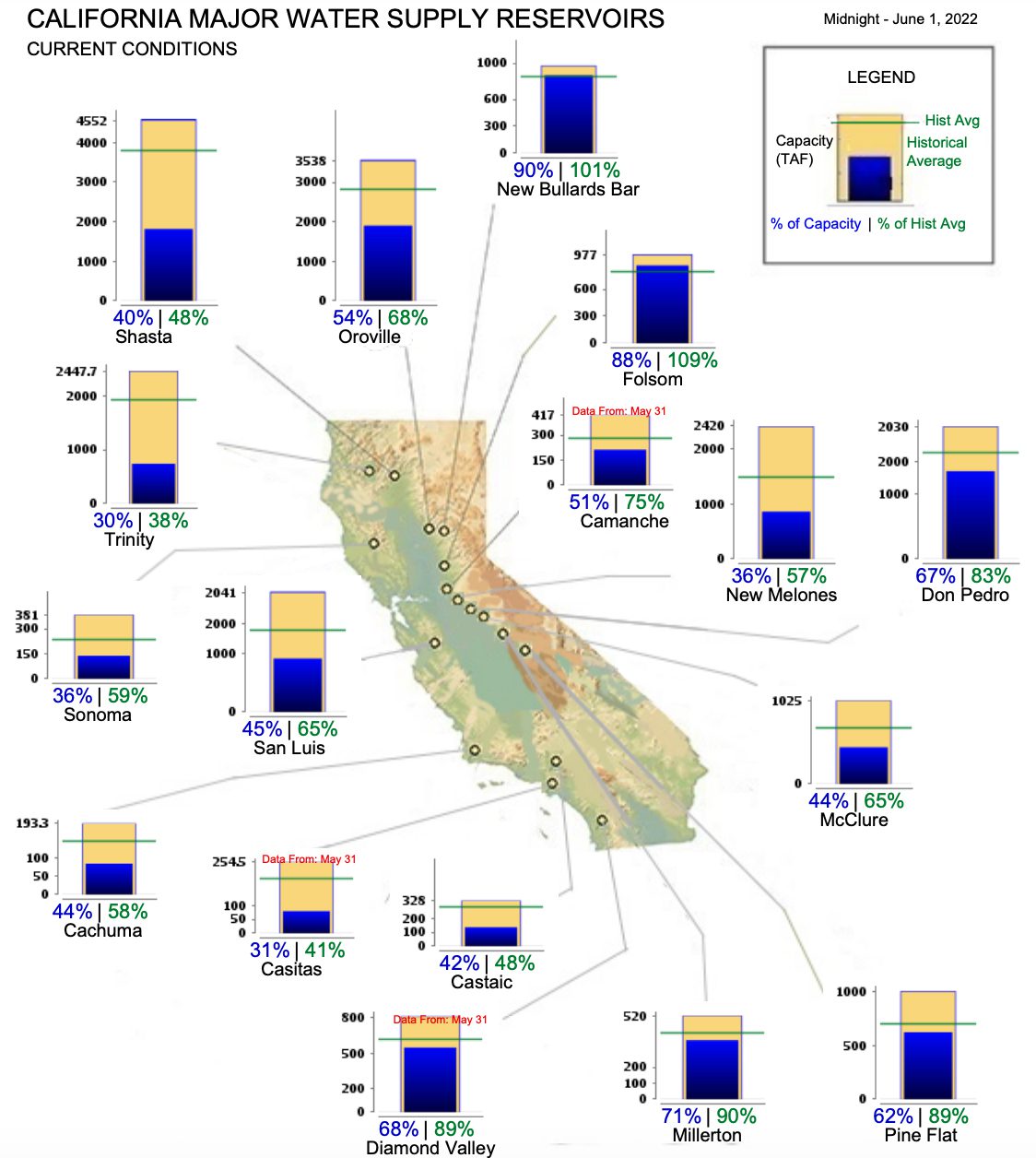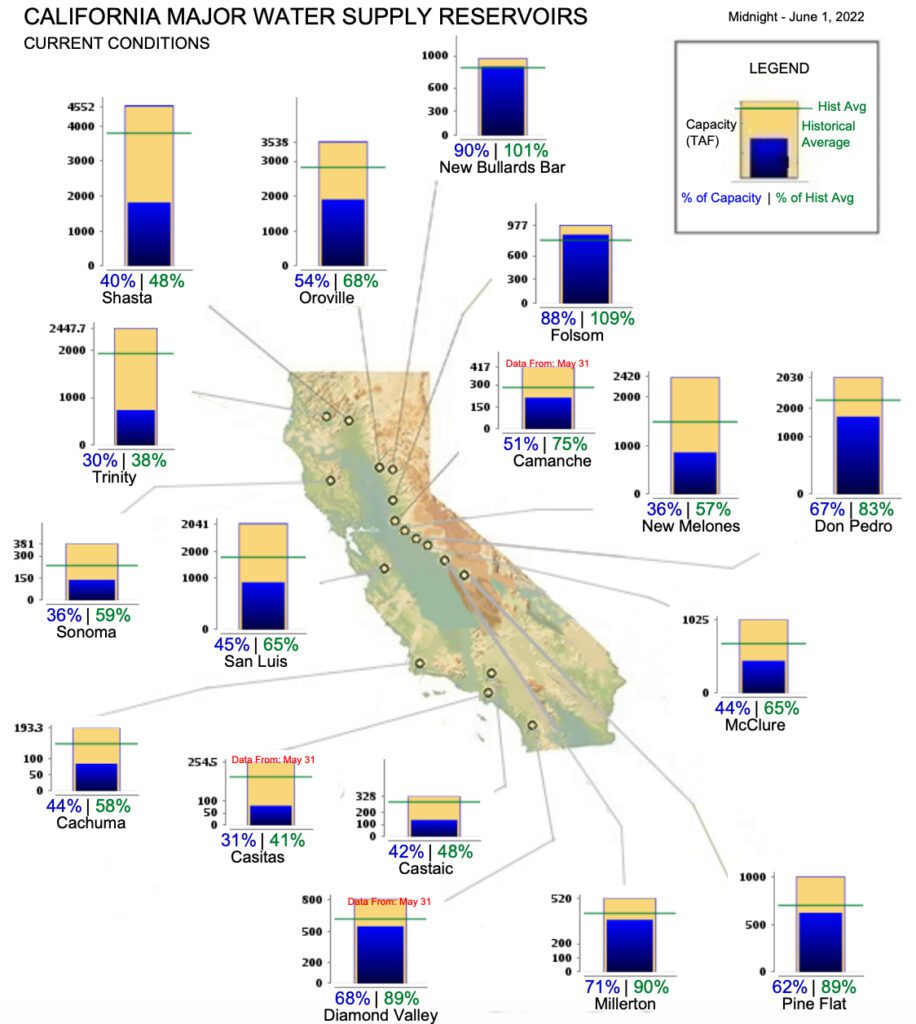California Drought Could Severely Limit Hydropower This Summer

Drought in California could nearly halve the state's hydroelectric generation this summer, pushing up wholesale power prices in the West, and forcing the state to rely on natural gas generation and out-of-state imports, the Energy Information Administration (EIA) projects in a new analysis.
The EIA suggests in a supplement to its May 2022-released Short-Term Energy Outlookthat current drought conditions in the state potentially have a significant impact" on power markets throughout the West from June through September 2022. That impact could be different than in past years, given the state's accelerating growth in intermittent generating capacity and reliance on imports," which accounted for nearly one-third of California's power supply in 2020, it said.
Conditions this summer are especially precarious given that California has experienced more frequent and intense drought conditions over the past decade-and it is currently grappling with a third continuous year of drought.
During the 2022 water year, which began October 1, 2021, snowpack reached above-normal levels in December, but dry conditions then persisted through March. As of April 1, which typically marks the peak of snowpack, California's snowpack had an equivalent water content of 6.9 inches, which is about 40% below the median value from 1991 through 2020," the EIA explained. Less snowpack means that, as temperatures warm in the spring, less snow will melt and flow into California's reservoirs."
Drought Widely Affecting Major ReservoirsAccording to the California Department of Water Resources, every reservoir in California is suffering below-average conditions. These include reservoirs where some of the state's largest hydropower generators are located, such as the 644-MW Edward C. Hyatt plant at Lake Oroville; the 300-MW New Melones plant at New Melones Lake; the 714-MW Shasta plant at Shasta Lake; the 140-MW Trinity pant at Trinity Lake; the 207-MW Folsom plant at Folsom Lake; and the 315-MW Colgate plant at New Bullards Bar Reservoir. The six plants, notably, are the focus of the EIA's modeling in the May-released supplement. The six projects accounted for 22% of California's total hydropower generation over the previous five years, the EIA notes.
 Current conditions (as of June 1, 2022), at California's major water supply reservoirs. Source: California Department of Water Resources.
Current conditions (as of June 1, 2022), at California's major water supply reservoirs. Source: California Department of Water Resources.
Under a scenario modeling drought case water conditions"-which represent the current year as of April 1-California's summer hydroelectric share of its generation mix may be nearly halved, falling from 15% of total generation to 8%. To offset the lost hydro generation, the EIA projects California will be forced to buy more power from neighboring markets and increase its in-state gas generation this summer.
Gas generation's share could meanwhile rise substantially, from 45% in the Median" scenario-which is modeled on water supplies based on data from 1980 to 2020-to 50% in the drought scenario. While the EIA did not explicitly model the impact of drought on water-cooled thermal power plants, it said drought is not expected to have a significant near-term effect on thermal generation in California."
Higher Wholesale Power Prices in the WestThe drought scenario notably suggests California's increased gas generation will contribute to higher modeled wholesale power prices, as well as to a surge in carbon dioxide emissions. On-peak prices in Northern California-where most of California hydroelectric plants are located-could increase by 7% relative to the Median case, while Southern California's on-peak prices are 5% higher, it said.
Prices in neighboring power markets could also rise. We forecast higher prices in neighboring power markets because less available hydropower in California means California will need to import more electricity into the state from neighboring regions, which puts pressure on power supplies in those markets," the EIA said. Although Arizona and Nevada are also experiencing drought conditions, we did not include the effect of drought outside of California in this analysis. If we had included other regions, price increases in Southern California and Arizona would have been higher."
 Source: U.S. Energy Information Administration: Short-Term Energy Outlook Supplement: Drought Effects on California Electricity Generation and Western Power Markets (May 2022)
Source: U.S. Energy Information Administration: Short-Term Energy Outlook Supplement: Drought Effects on California Electricity Generation and Western Power Markets (May 2022)
While the EIA's supplement is focused on California, drought conditions in much of the U.S. Southwest have prompted urgent action from power and water suppliers. The U.S. Bureau of Reclamation (USBR) in early May, notably, warned that Lake Powell's water surface elevation fell to 3,522 feet-its lowest level since the reservoir on the Arizona-Utah border was originally filled in the 1960s. (It was at 3,531 feet on May 31.)
A critical elevation at Lake Powell is 3,490 feet, the lowest point at which Glen Canyon Dam can generate hydropower," USBR explained. This elevation introduces new uncertainties for reservoir operations and water deliveries because the facility has never operated under such conditions for an extended period."
The extraordinary conditions prompted USBR for the first time to invoke its authority to change annual operations at Glen Canyon Dam and protect the 1.3-GW hydropower plant's components while securing crucial water supplies to consumers. At Lake Mead on the Arizona-Nevada border, where the iconic 2-GW Hoover Dam is located, elevation hovered at 1,048 feet. Hoover Dam needs a power pool minimum elevation of 950 feet to produce power (with an expected capacity of 650 MW).
 According to the U.S. Bureau of Reclamation (USBR), drought is affecting most of its reservoirs in the southern U.S. This image shows current reservoir storage as of May 31, 2022. Source: USBR
According to the U.S. Bureau of Reclamation (USBR), drought is affecting most of its reservoirs in the southern U.S. This image shows current reservoir storage as of May 31, 2022. Source: USBR
California's generating portfolio has shifted dramatically since 2015, a year like 2022 that was preceded by a dry year, but it also has more balancing tools at its disposal, the EIA points out.
Since 2015, 58% of the state's steam turbine natural gas units-a combined 6.5 GW-have been retired, while solar capacity has increased by 8.8 GW. California has also added 2.3 GW of battery storage capacity. However, even when California's battery capacity additions are considered, the total share of dispatchable resources is lower in 2022," a factor that is compounded by the loss of hydropower generation, a key source of operational flexibility that is well-suited for ramping up and down to offset changes in renewables, the EIA said.
An especially valuable attribute to moderate drought impacts may come from the California Independent System Operator's (CAISO's) Western Energy Imbalance Market (WEIM), a real-time energy market that has gained 19 participants since its inception in 2014, the agency suggested. WEIM's 19 participants currently serve 77% of power demand in the Western U.S.
 Using diverse and flexible energy resources from Western Energy Imbalance Market (WEIM) participants, the real-time energy market's sophisticated technology" finds and delivers the lowest-cost energy to its members. Operated by the California Independent System Operator (CAISO) since late 2014, the WEIM as of June 2022 had 19 participants serving 77% of the demand for electricity in the Western U.S.. Courtesy: CAISO
Using diverse and flexible energy resources from Western Energy Imbalance Market (WEIM) participants, the real-time energy market's sophisticated technology" finds and delivers the lowest-cost energy to its members. Operated by the California Independent System Operator (CAISO) since late 2014, the WEIM as of June 2022 had 19 participants serving 77% of the demand for electricity in the Western U.S.. Courtesy: CAISO
Newer notable members that joined the market in May include the Bonneville Power Administration (BPA), a nonprofit federal power marketer that sells hydropower from 31 federal dams in the Columbia River Basin, and Tucson Electric Power (TEP), which serves customers in southern Arizona. CAISO has noted the Federal Columbia River Power System in the Northwest is a vital source of clean energy that will bring significant resource diversity and transmission capability to the WEIM," while Tucson Electric Power's participation offers another highly valued partner in the Desert Southwest."
WEIM's market characteristics make it well-suited" for integrating more intermittent resource energy into the grid, the EIA noted last week. The market solves for every five-minute interval, enabling a west-wide market solution to the intra-hour, generation variability of intermittent resources and system load. In addition, because all participants submit offers into this automated market, WEIM provides a structure for solving each five-minute interval with lower cost resources," it said.
-Sonal Patelis a POWER senior associate editor (@sonalcpatel,@POWERmagazine).
The post California Drought Could Severely Limit Hydropower This Summer appeared first on POWER Magazine.